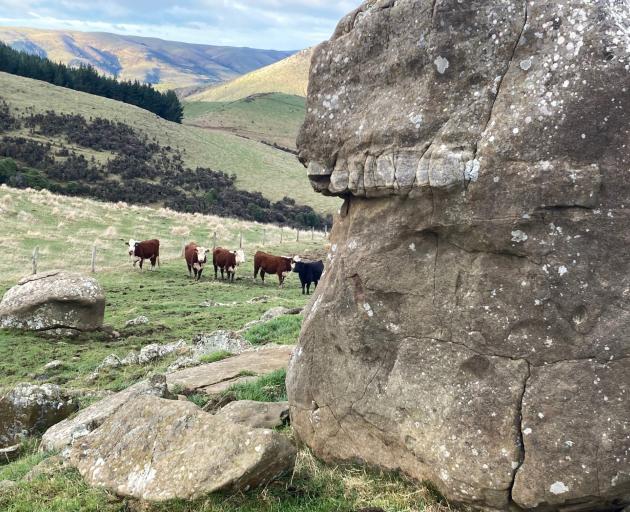
They do not come much bigger or rounder than those on the McNab farm at Lochindorb, near Owaka.
The farm is surrounded by the Wisp and Kaihiku Ranges and it is easy to imagine Jurassic-sized creatures heaving chunks of rocks like marbles that over millions of years eroded and formed the curious gigantic orbs that dot the peaks and paddocks of the property.
Peter McNab’s father, Bill, was something of an amateur geologist and knew a lot about rocks.
‘‘He could give explanations but as a kid they went over my head.’’

Many were transported by river, glacier or sea that rounded the rocks as they rolled along to form the perfectly spherical shape common in big boulders.
Two types were commonly found in the Catlins: conglomerate rocks formed from rounded gravel and boulder-sized clasts (fragments of other rocks and minerals) that stuck fast together; and sandstone rocks formed from cemented sand-sized clasts.
The Catlins has some of New Zealand’s oldest sedimentary rocks.
A few have found their way into the McNab garden and were a definite feature of the property, a trend started by Bill, who bought Lochindorb in 1952.
The McNabs have a history in the Catlins that spans more than a century.
Peter’s grandfather, Tom, farmed at Tahatika, in the nearby Owaka Valley, from 1919, and where Bill was born in 1922.

Tom was not a farmer by any means. He was a former gardener for Sir Truby King, who also had strong Catlins farming connections, at the Seacliff mental hospital north of Dunedin.
Tom bought a transport business in Dunedin, and during the flu epidemic after World War 1, spent weeks picking up the dead with his wagon, taking them to the morgue. After that, he decided to try his hand at life on the land.
‘‘He knew nothing about farming. He knew about gardening. After he bought the farm, he’d ride up the valley and see what his neighbours were doing and go home and do it,’’ his grandson said.
Rabbits were a big problem and, in the 1930s, Tom and his four boys, Tom jun, Colin, Bill and Jack came up with the rather radical idea of making a rabbit fence, which proved very effective. No-one believed Tom’s claim that he was rabbit-free.
‘‘He said, ‘I’ll give you a pound for ever rabbit you catch’. No-one ever got a pound,’’ Mr McNab said.
The philosophy was adopted by district rabbit boards, which began to be set up in 1938.

Bill, as the second youngest son, did not set out to become a farmer. He went to teachers college, but after World War 2, became restless and went shearing and fencing.
He ended up on a West Otago farm working for a childless couple who helped him into buying Lochindorb. The former owners, the Findlaysons, were also supportive of him buying the farm.
Bill met his wife, Muriel, on Gimmerburn Station, where he was shearing for her parents, and together they developed Lochindorb from the 1950s onwards.
Their commemorative plaques were attached to a big tombstone-shaped boulder that was hauled up to Rocky Dome overlooking the farm.
Peter could remember some pretty hair-raising rock-moving experiences with a Hough loader, when the back wheels completely lifted off the ground with the weight in the bucket. Some of the rocks weighed 2 tonnes — and they were the small ones.
‘‘We’ve got a lot of rocks. There’s some big stones — 50-60 tonnes, as big as [the height] of this room.’’
When Peter took over the property, he began taking more of an interest in the geology.
‘‘We’re quite attached to them. A bit of rock goes wherever we go.’’
That includes to his son Lyndon and daughter-in-law Jade’s cafe and venue hire business in the former Port Molyneux School, near Kaka Point, where the Lochindorb rocks feature strongly.
‘‘We brought them from 20km inland to 5m above sea level.’’
Some came from high up on the farm, 500m above sea level, and were probably once at sea level, millions of years ago, he said.
Aesthetically pleasing and unique, they also served a useful purpose on the farm.
‘‘If you go into the paddock with the big boulders, they act as shelter for the stock.
‘‘It’s almost as good as having a shed, because they’re protected from the weather.’’
- By Mary-Jo Tohill













